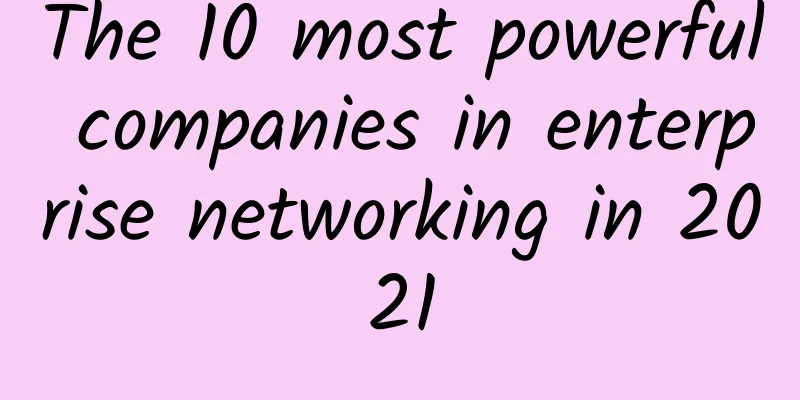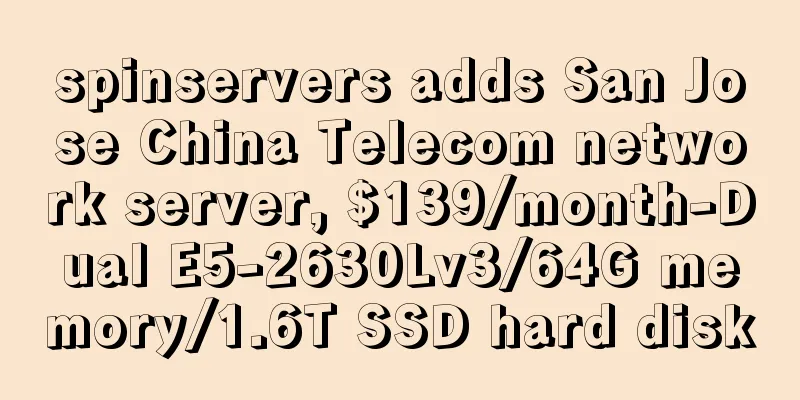The 10 most powerful companies in enterprise networking in 2021

|
Last year, the global spread of the epidemic forced employees to start working from home, and companies began to quickly migrate applications to the cloud. Secure remote access became critical. As the post-epidemic era approaches, it is clear that corporate networks have changed forever. Enterprise organizations are looking to new technologies like Secure Access Service Edge (SASE) to combine network and edge security into a single manageable platform. In a world where traditional perimeters no longer exist, more and more enterprise organizations are looking for more effective ways to fight cyberattacks, and zero trust network access has thus been upgraded from a side issue to a hot issue. The boundary between security and networking is becoming blurred. Traditional security companies are entering the networking field, and networking companies are also laying out their security areas. The following companies that made it to the “Top 10 Most Powerful Companies in Enterprise Networking” have proven that they not only have a clear understanding and vision for the future of networking, but also have solid strategic plans in place to achieve their goals. Here's our overview of what makes these 10 networking equipment vendors the most powerful in the enterprise. (Editor's note: Strength is a subjective quality, and this list is not a ranking based on simple, quantifiable indicators. Our list is sorted based on the opinions of industry observers to show you those companies that are making great changes and have the broadest impact on the network industry.) 1. Cisco: Staying ahead with SASE, Zero Trust, IoT, and NaaSReason for selection: There is a reason why no one can beat Cisco's position as a major networking vendor. SASE: Offers an integrated package that includes technologies from strategic acquisitions, such as SD-WAN from Merak, remote access from AnyConnect, and zero trust from Duo. Network as a Service (NaaS): Cisco recently announced a subscription-based NaaS service called Cisco Plus. Internet of Things: Cisco's Cisco Kinetic platform covers this. In addition, Cisco remains the market leader in core categories such as Ethernet switch revenue: IDC data shows that the epidemic caused Cisco's switch revenue to fall by nearly 10% in 2020, but Cisco still has a leading 39% market share. Powerful moves: Cisco has been on an acquisition spree lately, including Fluidmesh (industrial IoT and connected vehicles), Kenna Security (vulnerability management), and Sedona Systems (software-defined networking). The numbers: Cisco reported third-quarter revenue of $12.8 billion, up 7%, driven by strong growth in security (up 13%), infrastructure platforms (up 6%), and applications (up 5%). Outlook: In the post-epidemic era, enterprises will reshape their business models, and IT spending is expected to increase in multiple areas - IoT, SASE and zero trust are the top three. By providing a broad portfolio of hardware, software and services, Cisco is well positioned to take advantage of CIOs' desire to reduce their reliance on single point products and identify a limited number of strategic partners, gaining the strongest position. 2. VMware: Finally free! VMware is ready to innovate and growWhy it's on the list: VMware has successfully expanded its portfolio from server virtualization to containers, security, cloud migration, cloud management, endpoint management, SD-WAN, hyperconvergence, and advanced networking. But it's been an eventful few months for VMware. In January, CEO Pat Gelsinger jumped ship after 10 years at the helm and returned to Intel, where he previously worked for 30 years. Even more troubling, in April, Dell dropped a bombshell, announcing that it was spinning off VMware. (EMC acquired VMware in 2004; Dell acquired EMC in 2016, and VMware was part of the deal). Powerful move: Becoming an independent company again may be VMware's strongest move yet, as it works to become an innovator in software while also partnering with EMC and Dell (both hardware companies at heart). Data: Dell acquired 81% of VMware in its record-breaking $67 billion acquisition of EMC in October 2015. Under the terms of the spin-off, the sale is expected to generate $9.5 billion in proceeds, which Dell will use to pay down the massive debt it incurred when it initially purchased the company. Outlook: The relationship between Dell and VMware has always been a mismatch. VMware prides itself on operating independently but is still owned by Dell, with its products sold through Dell channels and the two companies jointly developing technologies such as hyperconverged infrastructure. While VMware and Dell will continue to have a close partnership, analysts say the split will make VMware more nimble, and the increased level of independence will make it possible to strike deals with Dell competitors. 3. Arista: Focus on cloud services powered by AI for security and networkingReason for selection: Speaking of Arista, you may be unfamiliar with it, but if I say that it is one of the few network vendors that has the strength to compete with Cisco, you may understand its "status in the world". Arista understands that simply taking market share from Cisco in the high-speed switching market and over-relying on revenue from Facebook and Microsoft is not a winning strategy for achieving sustained growth. The company is enriching its product portfolio, targeting the campus switching market, providing network management, and entering the fields of security, Internet of Things, and artificial intelligence. Recently, Arista announced the launch of a zero-trust product based on network segmentation. In this era that emphasizes speed and innovation, Arista has always billed itself as a "cognitive cloud network" company. Strong Move: Acquired Awake Security, a company that provides AI-driven proactive threat detection services for IoT campus networks. Number: Over the past decade, Arista's market share in high-speed switches has climbed from 3.5% to 16.3%. (Cisco's has slipped from 78.1% in 2012 to 43.7% in the first half of 2020.) Outlook: Arista emerged from the pandemic in pretty good shape under the steady leadership of Jayshree Ullal, one of the few female CEOs in the technology sector. The company reported a 27% increase in revenue in the first quarter and a solid operating profit of nearly $200 million. On the product side, Arista has been focusing on AI-driven secure networks and has done a good job. 4. HPE/Aruba: Leading in SASEReason for selection: HPE's Aruba provides a powerful set of features for enterprises that need to integrate wired and wireless LAN, edge infrastructure and cloud access for branch offices and remote employees in an automated and secure manner. Gartner ranked Aruba as a leader in the wired/wireless LAN access market, noting that "Aruba ClearPass (secure network access control) and AirWave (network management) capabilities will continue to serve as market standards. Aruba will also continue to be an influencer of market competition trends." At the same time, HPE is advancing its GreenLake local cloud, consumption-based products, and plans to offer each of its services and products through GreenLake leasing by next year. Powerful move: Acquired SD-WAN giant Silver Peak, one of the key companies challenging Cisco's dominance in the SD-WAN market. Data: HPE (which acquired Aruba six years ago) acquired Silver Peak for $925 million. Outlook: Aruba has become a leader in the emerging SASE market by integrating Silver Peak technology into its product line, according to a new report from the 650 Group. HPE said its intelligent edge revenue was $806 million in its latest earnings report, up 12% year-over-year. It expects Aruba to "continue to take share in campus switches and WLANs." However, Aruba's prospects became less clear in early June when co-founder and permanent CEO Keerti Melkote announced that she would leave. In addition, Aruba's permanent CTO Partha Narasimhan and chief architect Pradeep Iyer also left the company. HPE has appointed Phil Mottram, senior vice president of HPE Communications Group, to replace Melkote as CEO, and Silver Peak's David Hughes will take on the role of chief product officer and CTO. One of Aruba's strengths is its stable leadership team, which has been driving innovation for nearly 20 years, so a reorganization of this magnitude is noteworthy. The fact that HPE chose someone from outside Aruba to take over is also noteworthy. Melkote and his team have managed to keep Aruba independent within the HPE family, so it will be interesting to watch how this plays out. 5. Extreme Networks: Integrating recent acquisitions and laying out future plansReason for selection: Extreme Networks went on an acquisition spree between 2016 and 2019 (Zebra Technologies' WLAN, Avaya's networking business, Brocade's switches, routing and analytics, Aerohive's Wi-Fi 6 equipment, SD-WAN software and cloud management services). It worked hard to integrate these products and technologies and stand out with a coherent strategy. Gartner said Extreme has "successfully" integrated its acquisitions and ranked it as a leader in wired and wireless LAN access infrastructure. Gartner said, "Extreme combines its end-to-end wired switch and WLAN products with a broad portfolio of cloud-managed and locally managed network applications and services." Powerful moves: At its latest user conference, Extreme announced its overarching vision for the future, the "Infinite Enterprise." The idea is that in a post-pandemic world, businesses will need to adapt to the needs of a global, hybrid workforce. The key principles are distributed connectivity, a scalable cloud, and a consumer-centric user experience. Data: ExtremeCloud IQ cloud management subscription service grew 122% year-over-year. Outlook: The latest fiscal quarterly report shows Extreme's significant achievements in cloud management, automation and artificial intelligence - revenue increased by 21% year-on-year. President and CEO Ed Meyercord firmly believes: "Extreme has emerged from the difficulties caused by the epidemic in a stronger position than ever before. Enterprise customers are turning to Extreme's industry-leading cloud solutions to meet the new needs of distributed enterprises." 6. Palo Alto: From firewall to cloud security platformReasons for selection: As the pioneer of application-aware next-generation firewalls, Palo Alto has successfully expanded its scope through a series of acquisitions in the past three years: cloud security company RedLock, security orchestration company Demisto, container security company Twistlock, serverless security startup PureSec, IoT startup Zingbox, micro-segmentation company Aporeto and SD-WAN company CloudGenix. Palo Alto has integrated these acquisitions into a broad cloud security platform called Prisma Cloud, which addresses security issues throughout the application lifecycle. According to Gartner, Palo Alto has used the acquisition of CloudGenix to become a leader in the SASE field. Strong moves: Last November, Palo Alto Networks announced its intention to acquire attack surface management vendor Expanse for $800 million. In February, Palo Alto acquired cloud security company Bridgecrew. Data: Palo Alto Networks acquires attack surface management vendor Expanse for $800 million. Outlook: Palo Alto continues to build on its popular core firewall business with revenue from fast-growing areas such as SD-WAN, SASE, and cloud security. The company has also successfully moved to a subscription model with its Firewall as a Service (FaaS) product. More recently, it has boosted its zero-trust offering with Cloud Identity Engine, which allows customers to authenticate and authorize users across enterprise networks, clouds, and applications. So far, the strategy appears to be paying off: Revenue for the quarter ended April 30 grew 24% year-over-year to $1.07 billion. 7. Fortinet: Broad platform for security/network convergenceReason for selection: The convergence of security and networking is a perfect storm for Fortinet. The company has taken a leading position in SASE, zero trust and cloud management with its self-developed next-generation firewall, antivirus software, SD-WAN, Ethernet switch and wireless equipment product lines. Gartner said that in its latest Magic Quadrant for Wired and Wireless LAN Infrastructure, Fortinet has leapt from a niche player to a "visionary" company with its "security-centric full branch/campus network stack, including wired, wireless, security and edge networks." Strong Moves: Fortinet recently acquired OPAQ Networks, which provides a zero-trust network access cloud product. Data: Fortinet acquires Panopta for $34 million. Panopta's tools can automatically manage servers, containers, applications, databases, cloud infrastructure and virtual appliances. Outlook: Nearly 20 years ago, brothers Ken and Michael Xie founded Fortinet and are still at the helm; Ken is CEO and Michael is CTO. Their steady leadership and vision have enabled Fortinet to purposefully build its products so they can be integrated into platforms such as the Fortinet Security Fabric and the Fortinet Cloud Management System, all of which can be run from a single console. In the most recent quarter, Fortinet reported strong earnings, with total revenue up 23% year-over-year to $710 million. (It should be noted that the FBI had already warned this spring that hackers had successfully exploited a vulnerability in the Fortinet operating system. In response, Fortinet pointed out that the vulnerability was an old one and urged customers to update their software to the latest version.) 8. Juniper Networks: Embedding AI in its product lineReason for selection: As one of the few original network vendors still standing, Juniper Networks is taking active steps to transition to growth areas such as SASE, artificial intelligence, SD-WAN, wireless and intent-based networking. This has been achieved through the acquisition of wireless innovator Mist Systems, and Juniper Networks has subsequently launched products that leverage Mist's AI capabilities in data centers, clouds and hybrid environments. Gartner said that Juniper is a visionary in the field of WAN edge infrastructure, with "comprehensive solutions, including reliable functions with SD-WAN, operations, deployment flexibility and strong security." In addition, Juniper was named a leader in Gartner's Magic Quadrant for Wired and Wireless LAN Access Infrastructure Based on AI-Driven Technology. Powerful moves: In January, Juniper acquired intent-based networking (IBN) pioneer Apstra and its Apstra operating system. Data: In December last year, Juniper acquired 128 Technology for $450 million. The company provides intelligent routing software that reduces the cost of running SD-WAN and WAN. Outlook: There’s no doubt that Juniper has struggled to recover from declining service provider revenues over the past few years. Juniper’s annual revenues hit $4.8 billion in 2015 and were just $4.45 billion in 2020. But analysts say Juniper may have turned things around. Junipe reported an 8% revenue increase in its most recent quarter. The infusion of new technology and talent from recent acquisitions gives Juniper an opportunity to take a leadership position in areas such as data center automation, SASE, open networking, SD-WAN, and artificial intelligence. 9. Nvidia: Relying on AI in enterprise data centers and working toward regulatory approvalReason for selection: As an innovator and a strong player in the gaming field, Nvidia hopes to become a leader in the deployment of artificial intelligence in enterprise data centers. Last year, Nvidia made two major acquisitions - the acquisition of intelligent switch manufacturer Mellanox and open source network operating system provider Cumulus for $6.9 billion. These moves provide Nvidia with a full stack of products from high-performance graphics processors to software platforms on which industry-specific artificial intelligence-driven applications can be built. Nvidia also cooperates with key industry suppliers such as VMware and RedHat to ensure that its GPUs can be integrated into various platforms. Powerful Moves: As if these key acquisitions weren’t enough, Nvidia announced last September its blockbuster acquisition of Arm Ltd., a company that doesn’t make chips itself but licenses its microprocessor technology to major computer hardware and smartphone OEMs. Data: Nvidia acquired Arm for $40 billion. Outlook: Nvidia can take advantage of the momentum of using artificial intelligence in data centers, clouds, and edge scenarios to maintain its favorable position. However, the acquisition of Arm seems to have received more and more opposition. ARM has always been neutral in the entire semiconductor industry, and even when it was acquired by SoftBank, it has never changed its attitude. But if ARM falls into the hands of Nvidia, all this may change. It is reported that the deal may not be completed before the final preset deadline (March 2022) because European regulators are unwilling to review the acquisition before September. In addition, Google, Microsoft, and Qualcomm have also raised objections because they are worried about whether they can continue to have equal access to Arm technology after the acquisition is completed. The US Federal Trade Commission (FTC) has launched an investigation, and in April, the United Kingdom (where Arm is headquartered) also announced plans to investigate whether the deal endangers the country's national security. Most importantly, Nvidia needs to get approval from China, where Arm's owner SoftBank is located, and trade relations between the United States and China are very cold now. In any case, Nvidia CEO Huang Renxun still believes that he can overcome regulatory obstacles and get the deal approved. 10. Dell Technologies: Divestitures, focuses on data center modernizationReason for selection: Under the helm of the thought-jumping Michael Dell, the development of Dell Technologies is never predictable. First, it spent $67 billion to acquire EMC, which owns VMware. Now, it is divesting VMware for about $9.5 billion in proceeds and using it to help repay the debt incurred when it originally acquired the company. According to Michael Dell, the move is good for both companies because each company will gain a certain degree of independence. He said Dell's future focus is on data center modernization, growing PC business, and building open ecosystems for hybrid and private clouds, edge, 5G, telecommunications and data management. Dell also hopes to become a leader in the IT as a service market through its APEX program. Powerful moves: In addition to the VMware spinoff, Dell is also selling its Boomi data integration software business to a private equity firm. Data: The sale of its Boomi data-integration software business netted Dell $4 billion, which it also expects to use to pay down debt. Outlook: Will the VMware spinoff actually change anything, or is it just a financial trick? The answer remains to be seen! After all, Michael Dell will continue to serve as VMware's chairman. VMware has signed a five-year commercial agreement to work with Dell on hyperconverged technology and share sales teams and financial services, so this is not a complete spinoff. Today, both companies are doing well and hope to do even better in the future. Dell has assembled a strong lineup of server, storage, and networking products and integrated them into a market-leading hyperconverged system with 32.6% market share, according to IDC. In the most recent quarter, Dell reported revenue of $7.9 billion in its Infrastructure Solutions segment, up 5%; server and networking revenue of $4.1 billion, up 9%; and storage revenue was flat. Segmented/segmented segment revenue was $788 million, up 8%. |
<<: NTT and CheckPoint Join Forces to Help Enterprises Defend Against Security Threats
>>: Vietnam to phase out 2G and 3G services from 2022
Recommend
[Black Friday] AlphaVPS: VPS annual payment starts from 9.99 euros, AMD EYPC+NVMe series starts from €18.99/year, Los Angeles/Bulgaria data center available
AlphaVPS has released this year's Black Frida...
Connecting the Next Billion: 5G and Satellite
5G will revolutionize the Internet of Things due ...
Cisco ASAP helps you to subvert the traditional architecture by starting the full digital transformation of data center
[51CTO.com original article] Enterprise digital t...
A brief introduction to RPC services | Network protocols at different layers
Author: Wang Yuzhan JD Health Network Protocol Wh...
How to apply code intelligence technology to daily development?
01/ Let’s start with the developers’ worries When...
ZJI: 570 yuan/month Hong Kong server-E5 2650, 32G memory, 480G SSD hard disk, 15M CN2+BGP bandwidth
This month, ZJI is offering a 40% discount on a d...
【WOT2018】Recommended search venue reveals the secrets and discusses how intelligent search can improve business value
[51CTO.com original article] In 2018, artificial ...
Four questions to help you understand what DCIM is?
[[126709]] Question 1. What is DCIM? DCIM stands ...
Six ways 5G can save the global supply chain
5G enables real-time data at the point of origin,...
5G-enabled IoT use cases
The commercial use of 5G provides enterprises wit...
Customize SD-WAN to meet your needs
Why do we always think we can adopt a revolutiona...
Live coverage of the 2018 Yunnan-Huawei Software Industry Summit: Accelerating software growth and empowering the digital economy
[51CTO.com original article] From December 20th t...
Ten rounds of fierce competition between NB-IoT and eMTC
This article systematically sorts out and analyze...
A multi-dimensional interpretation of the construction of my country's comprehensive network governance system
At present, in the ever-changing and complex inte...









